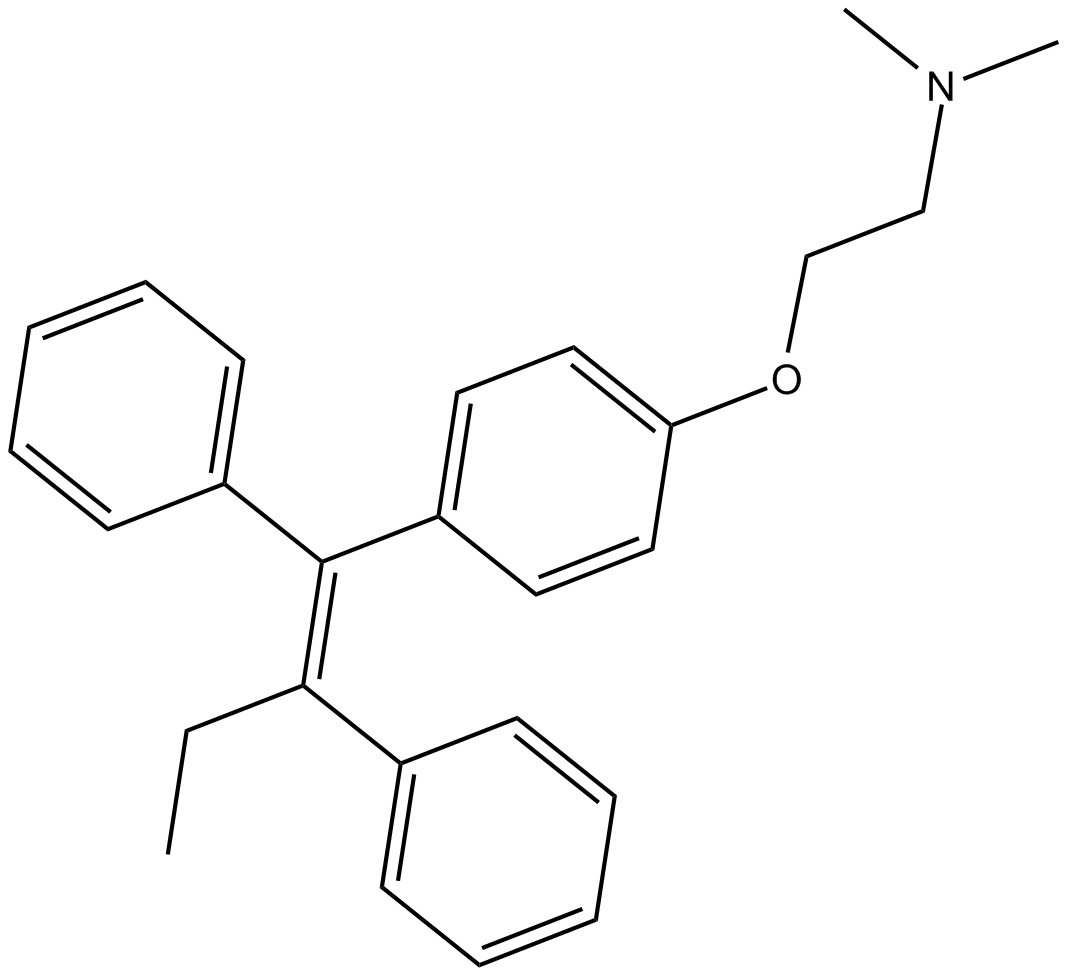Tamoxifen |
| Catalog No.GC17901 |
Tamoxifen(TAM) serves as a selective estrogen receptor regulator (SERM), inhibiting estrogen's effects in breast cells while potentially stimulating estrogen activity in cells found in different tissues.
Products are for research use only. Not for human use. We do not sell to patients.

Cas No.: 10540-29-1
Sample solution is provided at 25 µL, 10mM.
Tamoxifen(TAM) serves as a selective estrogen receptor regulator (SERM), inhibiting estrogen's effects in breast cells while potentially stimulating estrogen activity in cells found in different tissues. Moreover, Tamoxifen can function as an enhancer of Hsp90 chaperone ATPase activity. Furthermore, it has been shown to induce gene knockout in CreER(T2) mice[1-4].
Tamoxifen(1-10µM;24 h) treatment significantly reduced the levels of growth hormone (GH) and adrenocorticotropic hormone (ACTH) secreted by the GH3 and AtT-20 cells respectively[5]. Tamoxifen(0.1-100 µM;48h) decreased the mRNA expression of vascular endothelial growth factor-A (VEGF-A) and increased the mRNA expression of VEGF receptor-1 and placental growth factor (PLGF) in HEECs[6]. Tamoxifen Treatment(1µM; 24/48/96 h) can significantly inhibit the proliferation of MCF7 cells[7]. 5 µM Tamoxifen induces persistent ERK1/2 activation in ER+ breast cancer cells(MCF-7)[8].
Tamoxifen (20, 50 and 100 mg/kg;21 days) treatment not only led to a significant reduction in tumor volume and weight, but also decreased the plasma levels of GH in the tumor-bearing mice[5]. Mice were injected with Tamoxifen (75 mg/kg dissolved in corn oil for 5 days at 6 weeks of age;i.p.) causes floxed exon excision, resulting in gene knockout[9]. Tamoxifen(9 mg/kg;i.g.) exerts an inhibitory effect on the heterotopic bone progression at inflammation and chondrogenesis stages, with the TGF-ß signaling pathway suppressed following the increase in estrogen receptor alpha activity[10].
References:
[1]. Osborne CK. Tamoxifen in the treatment of breast cancer. N Engl J Med. 1998 Nov 26;339(22):1609-18. doi: 10.1056/NEJM199811263392207. PMID: 9828250.
[2]. Hawariah A, Stanslas J. In vitro response of human breast cancer cell lines to the growth-inhibitory effects of styrylpyrone derivative (SPD) and assessment of its antiestrogenicity. Anticancer Res. 1998 Nov-Dec;18(6A):4383-6. PMID: 9891496.
[3].Zhao R, Leung E, et,al. Tamoxifen enhances the Hsp90 molecular chaperone ATPase activity. PLoS One. 2010 Apr 1;5(4):e9934. doi: 10.1371/journal.pone.0009934. PMID: 20376192; PMCID: PMC2848575.
[4]. Feil S, Valtcheva N, et,al. Inducible Cre mice. Methods Mol Biol. 2009;530:343-63. doi: 10.1007/978-1-59745-471-1_18. PMID: 19266339.
[5]. Lv T, Zhang Z, et,al. Tamoxifen Exerts Anticancer Effects on Pituitary Adenoma Progression via Inducing Cell Apoptosis and Inhibiting Cell Migration. Int J Mol Sci. 2022 Feb 28;23(5):2664. doi: 10.3390/ijms23052664. PMID: 35269804; PMCID: PMC8910631.
[6]. Helmestam M, Andersson H, et,al. Tamoxifen modulates cell migration and expression of angiogenesis-related genes in human endometrial endothelial cells. Am J Pathol. 2012 Jun;180(6):2527-35. doi: 10.1016/j.ajpath.2012.02.026. Epub 2012 Apr 21. PMID: 22531128.
[7]. RondÓn-Lagos M, Rangel N, et,al. Effect of low doses of estradiol and tamoxifen on breast cancer cell karyotypes. Endocr Relat Cancer. 2016 Aug;23(8):635-50. doi: 10.1530/ERC-16-0078. Epub 2016 Jun 29. PMID: 27357940; PMCID: PMC5064758.
[8]. Zheng A, Kallio A, et,al. Tamoxifen-induced rapid death of MCF-7 breast cancer cells is mediated via extracellularly signal-regulated kinase signaling and can be abrogated by estrogen. Endocrinology. 2007 Jun;148(6):2764-77. doi: 10.1210/en.2006-1269. Epub 2007 Mar 15. Erratum in: Endocrinology. 2007 Aug;148(8):3931. PMID: 17363451.
[9]. Kedjouar B, de MÉdina P, et,al. Molecular characterization of the microsomal tamoxifen binding site. J Biol Chem. 2004 Aug 6;279(32):34048-61. doi: 10.1074/jbc.M405230200. Epub 2004 Jun 2. PMID: 15175332.
[10]. Mao D, Mi J, et,al. Tamoxifen Inhibits the Progression of Trauma-Induced Heterotopic Ossification in Mice. Med Sci Monit. 2019 Oct 21;25:7872-7881. doi: 10.12659/MSM.916733. PMID: 31631887; PMCID: PMC6820362.
Average Rating: 5 (Based on Reviews and 14 reference(s) in Google Scholar.)
GLPBIO products are for RESEARCH USE ONLY. Please make sure your review or question is research based.
Required fields are marked with *




















